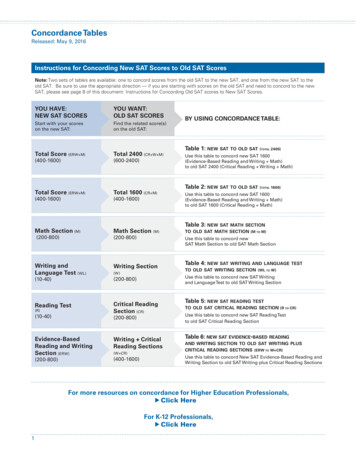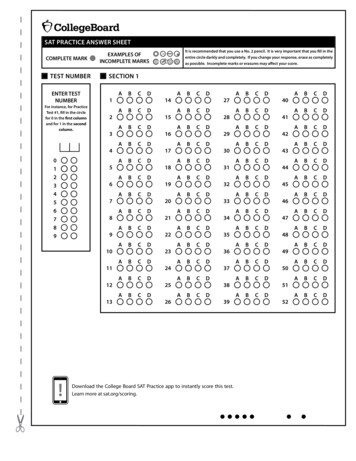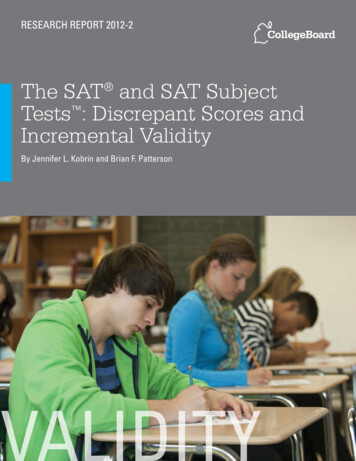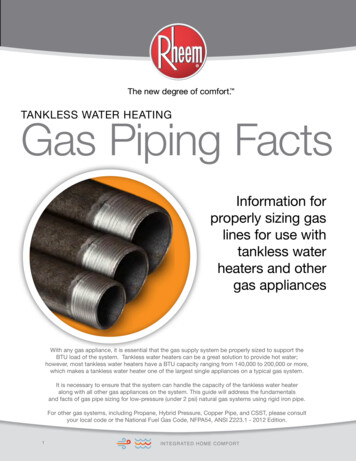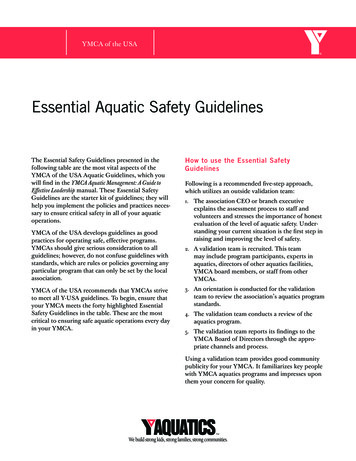
Transcription
Total Gas Saturation Considerations for RecirculatingAquatic SystemsG. RogersAquatic EcoSystems, Inc.2395 Apopka Blvd.Apopka, FL 32703 USAgaryr@aquaticeco.comKeywords: Zebrafish, Danio rerio, recirculating systems, water quality,total gas pressure, total gas supersaturationABSTRACTZebrafish (Danio rerio) are now widely used in aquatic research facilitiesfor genetic and vertebrate development studies. Most of these facilitiesutilize recirculating systems for zebrafish production. Dependableproduction of high-quality fish is of vital concern in these recirculationsystems as these fish are valuable and in many cases irreplaceable interms of their significance to the research being conducted.Water quality is of utmost concern in zebrafish systems. One criticalparameter that has received attention in these facilities is that of total gaspressure. Under abnormal conditions, the partial pressures of dissolvedgases in the water can be greater than saturation. When this is the case,there is a potential for problems with gas bubble trauma and an increasingchance for secondary microbial infections. This paper discusses total gassupersaturation theory, problems associated with supersaturation, methodsof monitoring total gas pressure, and ways that gas bubble problems canbe prevented in recirculating aquatic systems.INTRODUCTIONGas TransferUnder steady-state conditions, the partial pressures of dissolved gasesin water are in balance with the pressures of the same gases in theInternational Journal of Recirculating Aquaculture 6 (2005) 39-48. All Rights Reserved Copyright 2005 by Virginia Tech and Virginia Sea Grant, Blacksburg, VA USAInternational Journal of Recirculating Aquaculture, Volume 6, June 200539
Total Gas Saturation for Recirculating Aquatic Systemsatmosphere above the water. Henry’s law (Equation 1) is used todetermine saturation concentrations of dissolved gases (Colt 1984).C 1000 K ß X ((pATM - pH2O)/760)(1)Where: C Concentration of the gas (mg/L)K Ratio molecular wt of gas to volume (mg/mL)ß Bunsen coefficient for the gaspH2O Vapor pressure of water (mm Hg)pATM Barometric pressure (mm Hg)X Mole fraction of the gasAccording to Henry’s Law, when the pressure of gas over the wateris decreased, the amount of dissolved gas also decreases. In addition,the saturation concentrations of those gases will vary depending ontemperature, salinity, and pressure. Higher pressure increases the amountof gas dissolved per unit volume, so the saturation concentration for a gaswill be higher in deeper water. The inverse is the case for temperature andsalinity. Water at higher temperature or salinity will have less gas per unitvolume. Table 1 and Figure 1 present saturation concentrations for variousgases in water at different temperatures.Table 1. Sea level saturation concentrations of dissolved gases and watervapor pressure in freshwater at different temperatures (Colt 1984).40Temp(C .66.59.212.817.523.731.842.255.3International Journal of Recirculating Aquaculture, Volume 6, June 2005
Total Gas Saturation for Recirculating Aquatic SystemsFigure 1. Sea level saturation concentrations of dissolved gases and water vapor pressure infreshwater at different temperatures (Colt 1984).Gas Conc. (mg/L) andVapor Pressure (mmHg)60.050.0V.P. (mmHg)40.0CO2 (mg/L)30.0N2 (mg/L)20.0O2 (mg/L)10.0Ar (mg/L)0.00102030Temperature (C)40The sum of the partial pressures of all dissolved gases plus the vaporpressure of water is referred to as the Total Gas Pressure (TGP). Thedifference between TGP and atmospheric pressure is defined as DeltaP ( P). Both TGP and P are usually reported in mm Hg (millimetersof mercury). TGP may also be reported as a percent of sea level or localatmospheric pressure (TGP%). The following equations (Colt 1984)present these relationships:TGP pN2 pO2 pCO2 pH2O(2) P pN2 pO2 pCO2 pH2O – pATM(3)TGP P pATM(4)TGP% ( P pATM/ pATM) x 100(5) P (TGP% x pATM) 100 – pATM(6)International Journal of Recirculating Aquaculture, Volume 6, June 200541
Total Gas Saturation for Recirculating Aquatic SystemsWhere: TGP sum of the partial pressures of all dissolved gases and thevapor pressure of water (mm Hg) P difference between TGP and atmospheric pressure (mm Hg)TGP% TGP as percent of atmospheric pressure (mm Hg)pN2 partial pressure of dissolved nitrogen (mm Hg)pO2 partial pressure of dissolved oxygen (mm Hg)pCO2 partial pressure of carbon dioxide (mm Hg)pH2O vapor pressure of water (mm Hg)pAtm atmospheric pressure (mm Hg)Standard Methods for the Examination of Water and Wastewater (APHA/AWWA/WEF 1992) recommends reporting values of P rather than TGP%(percent saturation). However, percent of saturation has been widely usedin the past and is probably the most familiar method of reporting totalgas pressure data. The problem with the old data is that it was reported interms of TGP% without the corresponding barometric pressure data. As aresult it cannot be accurately converted to P values. Figure 2 presents therelationship between P and TGP% for different elevations.Figure 2. Relationship between P and TGP% at different elevations.120TGP%1152000 m1500 m1101000 m500 m105Sea Level1000255075100Delta P (mm Hg)42International Journal of Recirculating Aquaculture, Volume 6, June 2005
Total Gas Saturation for Recirculating Aquatic SystemsMeasurement of Dissolved GasesDissolved gases have been measured using manometry, volumetric tests,mass spectrometry, gas chromatography, chemical titration, direct sensingof pressure, and by headspace partial pressures (Tanner et al. 2003;Watten et al. 2004). The latter method is the most common means oftotal dissolved gas measurement and is completed using a saturometer ortensionometer. These devices use a gas permeable membrane (siliconerubber tube) that isolates the dissolved gases and water vapor from thesurrounding water. The membrane is connected to a manometer orpressure transducer for pressure measurement.These instruments measure either P or TGP. When a manometer is used, P (difference between TGP and barometric pressure) is recorded. If apressure transducer calibrated to absolute pressure is used, then TGP isreported. In this case, P may be calculated using the local barometricpressure. Other instruments utilize a pressure transducer set to zero at thelocal barometric pressure. The P is reported at that barometric pressure.These devices must be corrected for changes in local barometric pressure.The actual P experienced by aquatic animals is the difference betweenTGP and local pressure (barometric pressure plus the hydrostaticpressure). This would be the pressure inside and outside the fish. Gasbubbles will form only when the TGP is greater than the sum of thecompensating pressures (APHA/AWWA/WEF 1992; Colt 1984). Thecompensating pressure is the hydrostatic water pressure, the barometricpressure, and the pressure in the blood or tissues. Gas bubble trauma orgas bubble disease can result if the TDGuncomp is greater than 100% orif the Puncomp is greater than zero (see Equations 7 and 8). The depth ofwater where the Puncomp is equal to zero is referred to as the hydrostaticcompensation depth. Below this depth, it is not possible for dissolvedgases to form bubbles or for bubbles to come out of solution. Above thisdepth, bubbles may form both in the water column and in the blood andtissues of aquatic organisms (Colt 1984). Puncomp P – ρgZ(7)TGP uncomp [(pAtm P)/(pAtm ρgZ)] x 100(8)Where: Puncomp uncompensated P (mm Hg)TGP uncomp uncompensated total gas pressure (mm Hg)International Journal of Recirculating Aquaculture, Volume 6, June 200543
Total Gas Saturation for Recirculating Aquatic Systemsρ the density of water (kg/m3)g acceleration of gravity (9.8066 m/s2)Z depth (m)Before bubble growth can begin, a threshold P must be exceeded.Thus, the P is a direct indicator of the potential for aquatic and marineorganisms to develop signs of gas bubble disease.Causes of Gas SupersaturationNumerous sources of gas supersaturation have been reported in theliterature. Some of these include; 1) spill from dams, 2) power generationcooling water effluent, 3) solar heating, 4) geothermal heating, 5)photosynthesis, 6) groundwater, 7) airlift aeration and gas injectionsystems, 8) waterfalls, 9) pumping systems, 10) ice formation, 11)barometric pressure changes, 12) aircraft transport, and 13) ocean waves.For additional information on each of these processes, see the publicationby Fidler and Miller (1994).Gas supersaturation seldom develops in recirculating zebrafish growoutsystems. However, when it has occurred, there have been two primarycauses. The first cause is the rapid heating of water that is under pressure.This can occur in systems utilizing temperature-mixing valves. Becausegas solubility decreases as the temperature rises, cold supersaturatedwater can release bubbles as it is warmed (due to the reduced capacity ofthe warm water to hold dissolved gas). This may be the case when cold tapwater (pressurized to about 50 psi) in piping is depressurized to the localatmospheric pressure. A good practice would be to always degas sourcewater prior to use, especially if it has been heated by more than 5 C (10 F).The other cause of supersaturation in recirculating aquatic systems canbe the result of air drawn into a water pump. Within the pump, the air isforced into solution under high pressure resulting in supersaturation. Thismay be the case if there is an air leak in the piping on the suction side ofthe pump, if air is introduced in a sump near the pump inlet, or if a vortexforms in the sump or tank near the pump inlet. Air bubbles introducedinto the inlet of the pump by one of these methods may result in totaldissolved gas supersaturation levels as high as 110% in less than 5 minutes(unpublished data). Thus, it is very important to routinely ensure that noneof the following conditions are occurring: air leaks in suction piping, low44International Journal of Recirculating Aquaculture, Volume 6, June 2005
Total Gas Saturation for Recirculating Aquatic Systemswater levels causing a vortex in sumps, and the introduction of air bubblesnear the suction inlet of the pump.Problems Associated with Gas SupersaturationDissolved gas supersaturation has been shown to result in severalproblems for aquatic animals. Some of these conditions include; 1) bubbleformation in the cardiovascular system, 2) over-inflation and/or ruptureof the swim bladder, 3) bubble formation in the gills, 4) blistering in theskin particularly around the eyes, 5) bubbles in internal organs, 6) loss ofswimming ability, 7) susceptibility to secondary infections, and 8) alteredblood chemistry (Weitkamp and Katz 1980, Colt 1986, Fidler and Miller1994, Speare 1998).Figure 3. Macroscopic gasbubbles in the tissues aroundeyes of zebrafish exposed togas supersaturated water(signs of exophthalmia or“pop-eyed” appearance).(Photo courtesy of JenniferL. Matthews, D.V.M., Ph.D.,Zebrafish International ResourceCenter, University of Oregon.)Figure 4. Formationof gas bubbles intissues near the eyes ofzebrafish exposed to gassupersaturated water.(Photo courtesy of JenniferL. Matthews, D.V.M., Ph.D.,Zebrafish InternationalResource Center, Universityof Oregon.)International Journal of Recirculating Aquaculture, Volume 6, June 200545
Total Gas Saturation for Recirculating Aquatic SystemsWhen zebrafish are exposed to supersaturated water they can show signsof gas bubble disease. This is a non-infectious condition in which gasesfrom supersaturated water come out of solution forming gas bubbles in thecirculatory system and tissues of the fish. The major signs of gas bubbledisease in zebrafish are exophthalmia (pop-eyed appearance), abdominaldistension and hyper-buoyancy, gas bubbles in the skin, or general malaise(Jennifer L. Matthews, DVM, PhD, Zebrafish International ResourceCenter, University of Oregon, personal communication). The bubblesunder the skin can be visible to the naked eye (Figures 3 and 4). Thiscondition can further develop into areas of necrosis, secondary bacterialinfections, and eventually death. Diagnosis is based on the observationof gas emboli in capillaries of the gills or internal organs on wet mountexam or by observation of macroscopic gas bubbles in the eyes or skin.Dissolved Gas Levels of ConcernThe U.S. EPA has published a water-quality guideline that recommends amaximum TGP% of 110% of the local atmospheric pressure (U.S. EPA,1986). This guideline has been accepted by most states. However, therehave been numerous studies completed on dissolved gas supersaturationand gas bubble disease since the EPA guideline was developed. Thesestudies suggest that in some cases, the EPA guideline of 110% is too high.This is definitely the case in shallow applications and/or for certain lifestages of aquatic animals. Gas supersaturation values as low as 103% canbe dangerous for zebrafish, other aquatic species, or during particular lifestages. Adult fish have been shown to be more tolerant of higher total gaspressure than fry or juvenile fishes.In general, fish will move to deeper water to compress the gases. Thisprevents bubble formation in their circulatory system and body tissues.However, at a pressure of 103% gas supersaturation, the compensationdepth, or depth at which bubbles will not form in the blood of the fish, isonly about 12 inches. For every 1% increase in gas tension, the fish mustdescend 4 inches to compensate for the elevated gas pressure. If the fishtank is only 8-10 inches deep (as is the case with many tanks and aquariaused in research-scale-aquatic systems), the fish would not be able tocompensate for a gas supersaturation level of 103%.46International Journal of Recirculating Aquaculture, Volume 6, June 2005
Total Gas Saturation for Recirculating Aquatic SystemsCONCLUSIONSTotal dissolved gas pressure is the sum of the partial pressures of allgases dissolved in water plus the water vapor pressure. When the totalgas pressure in water is greater than the barometric pressure, the water issupersaturated. These conditions may cause gas bubble disease in fish andother aquatic animals. In lakes and rivers, the aquatic animals can usuallymove to deeper water to compress the gases. However, for tanks, aquaria,and other shallow settings their vertical movement is limited. Preventionof supersaturation can be extremely important in these cases.Though instances are rare, it is still possible for supersaturated conditionsto occur in laboratory recirculating systems. Supersaturation can result ifsource water is prepared by mixing cold and warm water, or if air bubblesare drawn into the water pump. Under these conditions, there is anincreased chance of gas bubble disease and/or a fish kill. Problems maybe minimized or eliminated if source water that has been heated morethan 5 C (10 F) is degassed prior to use. In addition, routine care must betaken to ensure that air bubbles do not enter the water pump. This meansnot allowing the water level of the sump to drop so low that a vortexforms and also ensuring that air bubbles are not drawn into the pump.REFERENCESAPHA/AWWA/WEF. Standard Methods for the Examination of Waterand Wastewater, 18th Edition. 1992.Colt, J. Computation of Dissolved Gas Concentrations in Water asFunctions of Temperature, Salinity, and Pressure. American FisheriesSociety Special Publication 14, 1984.Colt, J. Gas Supersaturation – Impact on the Design and Operation ofAquatic Systems. Aquaculture Engineering, 1986, 5:49-85.Fidler, L.E., and Miller, S.B. British Columbia Water Quality Guidelinesfor Dissolved Gas Supersaturation, 1994.Speare, D.J. Disorders Associated With Exposure to Excess DissolvedGases. In Fish Diseases and Disorders. Wallington, Oxon, UK.1998. Leatherland, J.F., and Woo, P.T.K., (Eds.). CAB InternationalPublications: Wallington, Oxon, UK.International Journal of Recirculating Aquaculture, Volume 6, June 200547
Total Gas Saturation for Recirculating Aquatic SystemsTanner, D.Q., Bragg, H.M., and Johnston, H.M. Total Dissolved Gasand Water Temperature in the Lower Columbia River, Oregon andWashington, 2003: Quality-Assurance Data and Comparison toWater-Quality Standards. Water Resources Investigations Report,2003, 03-4306.U.S. Environmental Protection Agency. Quality Criteria for Water. EPA440-5-86-001. 1986.Watten, B.J., Boyd, C.E., Schwartz, M.F., Summerfelt, S.T., and Brazil,B.L. Feasibility of Measuring Dissolved Carbon Dioxide Based onHeadspace Partial Pressures. Aquacultural Engineering, 2004,30 (3-4):83-101.Weitkamp, D.E., and Katz, M. A Review of Dissolved GasSupersaturation Literature. Transactions of the American FisheriesSociety, 1980, 109:659-702.48International Journal of Recirculating Aquaculture, Volume 6, June 2005
Dissolved gases have been measured using manometry, volumetric tests, mass spectrometry, gas chromatography, chemical titration, direct sensing of pressure, and by headspace partial pressures (Tanner et al. 2003; . A good practice would be to always degas source water prior to use, especially if it has been heated by more than 5 C (10 F).

